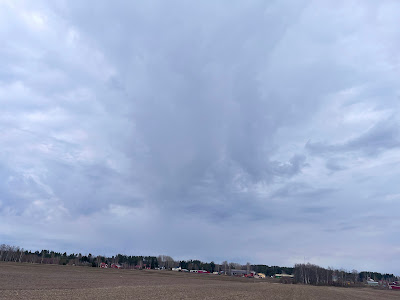As I was on a walk with my dog, I noticed that this cloud had a low hanging tail, which just means that it is raining.
And as we got nearer it seemed to fade away, but still visible.
And then we were directly under the tail and it didn't rain at first, but soon enough it rained.
Whole raining thing last quite short time, we walked less than 50 meters and we were on the other side of the tail. And then there were the sun.
Rain clouds don’t actually “hold” water like a bucket. Instead, they consist of countless tiny water droplets or ice crystals that are too small to feel the effects of gravity. Let me explain further:
Cloud Composition:
- Clouds are primarily composed of small water droplets and, in colder conditions, ice crystals.
- These particles are so minuscule that their fall velocity is negligible, making them appear to float in the air.
- The radius of a typical water droplet ranges from a few microns (thousandths of a millimeter) to a few tens of microns. Ice crystals are often slightly larger.
- Even a large water droplet with a radius of 100 microns falls at a speed of only about 27 centimeters per second (cm/s).
- Irregularly shaped ice crystals fall even more slowly due to their shape.
Why Clouds Float:
- The small size of cloud particles prevents them from rapidly descending.
- Upward vertical motions (updrafts) in the atmosphere contribute to the floating appearance of clouds.
- Clouds typically form, survive, and grow in air that is moving upward.
- Rising air expands as pressure decreases, causing cooling. This cooling leads to water vapor condensation, which sustains and enlarges the clouds.
Comparing Cloud Mass to Air Mass:
- Consider a hypothetical small cloud at an altitude of 3000 meters.
- Although it may contain a lot of water, this water is spread out over miles in the form of tiny droplets or crystals.
- The total mass of a cloud is relatively light compared to the mass of the surrounding air.
So, even though typical clouds contain a significant amount of water, it’s distributed across vast distances in the form of these tiny particles, defying gravity and creating the illusion of floating clouds
My other blogs:
Roadscape Photography
Chevrolet El Camino 1970
Life @ Köyliö, mostly Finnish




No comments:
Post a Comment